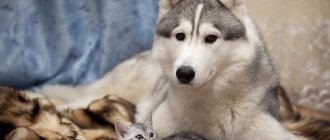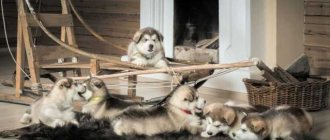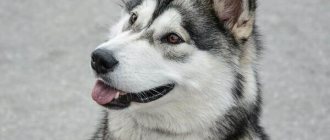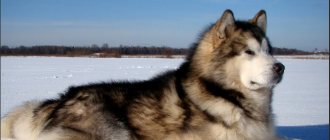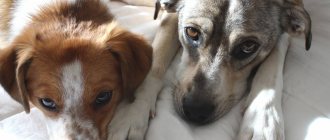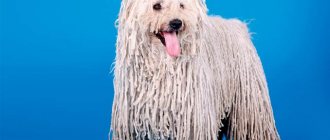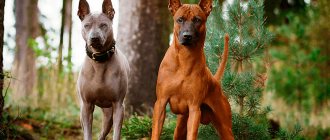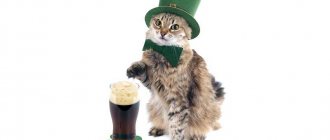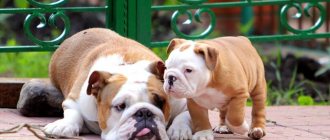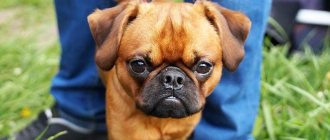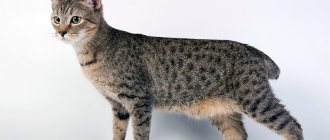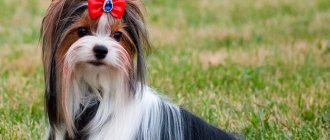This breed of dog belongs to large breeds, so the Alaskan Malamute is distinguished by its rather large dimensions and weight. Only an experienced dog breeder can handle such a dog, and the point here is not so much the size of the dog, but its difficult behavior.
Raising a dog of this breed should begin immediately upon purchasing a puppy. At the same time, the dog must understand who has more weight in the relationship and only then will it begin to obey. If this is not done, the dog will take over and turn into a spoiled and uncontrollable animal. If you raise a dog correctly, then a devoted and faithful friend will appear in the family, treating all family members with love.
Description of the Alaskan Malamute breed
Popularity 190th place among 263 dog breeds
Lifespan:
14-16 years old
Breed group:
Service
Height:
males: 63 cm, females: 58 cm
Country of origin:
USA
Average price:
20-30 thousand rubles
Weight:
males: 36-43 kg, females: 32-38 kg
Latest articles Cat health
Ataxia in cats: what it is, how it manifests itself and is treated 01/23/2022 151 0 0
Cat health
Leukemia, or viral leukemia in cats 01/23/2022 140 0 0
Price
The price of an Alaskan Malamute depends on its pedigree. An animal without one can be purchased for 10-12 thousand rubles. A puppy from purebred parents will cost over 25 thousand rubles. An animal born from dogs that have a number of titles and awards costs more than 35 thousand rubles.
Malamutes are very beautiful and gentle creatures, they love children and never conflict. But before you buy a dog, it is recommended that you once again read the information presented above. This will help avoid not only mistakes in parenting, but also disappointment.
Key facts
The description of the Alaskan Malamute breed emphasizes that it is a representative of a large breed of dog. The history of the origin of these northern giants is connected with the Malemute tribe, who previously lived on the coast of Alaska. From ancient times to this day, strongly built, muscular dogs easily cope with the work of dog sleds - all thanks to their physical endurance and resistance to harsh conditions. The external similarity of this beautiful dog with a wolf attracts increased attention.
The characteristics of the Alaskan Malamute breed say that the dogs are very smart and willful. The handsome Alaskan is good-natured, energetic and loyal, but by no means weak-willed or submissive. The stubborn nature of the Arctic giant and the desire to control his relatives and people sometimes prevent him from being raised under normal conditions. But when extraordinary situations arise, this character trait of the Alaskan Malamute can save a person.
The main feature of Malamutes remains their predisposition to draft work; without load, such dogs become lazy, spineless and stupid.
These giants are in good health, which is a great advantage of the breed. The lifespan of the Alaskan Malamute is long and easily reaches 15-16 years.
Kinds
Breeders standardized 2 types of breed - Kotzebue and M-lut. Each of them has a number of distinctive features. For example, the first one is less powerful and hardy. But such dogs are much kinder, and they also have well-developed sociable abilities. If we talk about m-loot, it is worth noting that this dog is capable of aggression. It is larger, has amazing endurance and strength.
Modern breeders often argue as to which of these types of Malamute is more correct. Most families prefer the Kotzebue, considering it a good, big guy. But there are husky lovers who need to protect their territory. M-loot is more suitable for them.
History of the origin of the Alaskan Malamute
The Alaskan Dog is the oldest representative of the indigenous dog breeds in North America. As archaeological excavations confirm, the Malamute is one of the first dogs domesticated by humans. Perhaps today's northern giants are descendants of once domesticated wolves.
When looking at these dogs, there really is a resemblance to wolves, which was proven by scientific research conducted in 2004.
The descendants of wolves came to Alaska thanks to their owners, who swam across the Bering Strait about 14 thousand years ago. The main purpose of the Alaskans was to transport heavy cargo in harsh Arctic conditions.
In ancient times, northern giants helped their nomadic owners hunt and also guarded their homes. Life in the far north played a huge role in the development of dogs as a breed. The constant lack of food, harsh living conditions, hopeless cold - all this contributed to the preservation of only those representatives who turned out to be stronger and more resilient than the rest.
At the end of the twentieth century, Alaskan Malamutes won the hearts of Europeans who came to Alaska under the influence of the gold rush. Streams of foreigners wanting to get rich from gold mining kept coming. And every European was interested in acquiring a convenient and reliable means of transportation on the ground.
Alaskans were the only animals that were able to withstand the harsh conditions of the north. They provided assistance in moving cargo and transporting people. The increased demand for these dogs contributed to an increase in their prices. By today's standards in dollars, then they paid for them from 13,000 for one unit and up to 40,000 for one team. Alaskans were in high demand among gold miners, despite the high price.
In an effort to obtain an even more hardy breed, Europeans tried to cross local Malamutes with Newfoundlands and St. Bernards brought specifically for this purpose. The breeders did not get the expected results, because the resulting offspring turned out to be unable to work as a team.
At the beginning of the last century, dog sled racing gained popularity in America. The sport gained historical fame in 1908 with a 408-mile race called the All Alaska Sweepstakes. Dogs from all over Alaska participated, and for the winning owners, this meant receiving monetary rewards and recognition.
But! Malamutes proved unsuitable for racing because they were not as fast as other competing dogs. Because of this, they tried to crossbreed Malamutes with representatives of small breeds. Attempts led to the threat of extinction of Alaskans as a species. In 1920, the number of these dogs reached a critical minimum. Only thanks to a team of enthusiastic breeders, consisting of several people, was it possible to preserve the breed.
The Second World War also caused great damage to the number of purebred dogs. The participation of four-legged helpers in hostilities almost led to the complete disappearance of the breed. In 1947, when there were only 30 Malamutes, through selection it was possible to restore the breed of Arctic beauties.
Today, Alaskans are considered a popular and famous dog breed. Many northerners will be happy to purchase such a pet. Adapted for centuries to hard work, dogs still perform their basic functions despite the fact that they have come to be considered the official symbol of the American state of Alaska.
TEMPERAMENT
The Alaskan Malamute is an affectionate, friendly dog, but not a “one-owner” dog. The Malamute is a loyal and devoted companion, playful when invited. Usually, after growing up, the Malamute is especially impressive with its sense of self-esteem.
The Malamute is a true pack animal with a natural instinct to “lead or be led.” This manifests itself in independence, self-confidence and strong willpower, and also explains why the Malamute can at times be aggressive towards dogs of the same sex. Although Malamutes have historically guarded Eskimo settlements and children, they are not the type of guard that perceives eye contact or the approach of a stranger as a threat. Dogs that react negatively to people do not exhibit the typical and correct Malamute temperament. Any sign of Malamute aggression towards people is unacceptable.
Young Malamutes will respond positively to any action that they perceive as an invitation to play, and curiosity may lead them to try to pull off the judge's dangling jewelry, hat or bodice.
Appearance of an Alaskan Malamute
General impression
The Alaskan Malamute is a powerful, hardy and friendly dog that looks very much like a wolf. This similarity causes not fear, but admiration. Even the photo of the Alaskan Malamute shows how beautiful and harmoniously built this dog is.
Head
Powerful, wide, deep-set. The head blends very harmoniously with the dog's body.
Neck
Strong, powerful, slightly curved.
Torso
Average, not very massive, but the bones are strong. Strong muscles are not visible under the thick fur - but rest assured, they are there.
Forelegs
The front legs of the Alaskan Malamute are quite well developed, they are distinguished by strong bones and powerful muscles. The paws are straight up to the pasterns, parallel to each other. The shoulder blades are slightly inclined. The pasterns are strong, but not long - deep, adapted for walking in the snow. The pads are well developed. The phalanges of the fingers are tightly pressed, curved. The claws are impressive.
Hind limbs
The hind limbs are no less powerful. Located on the same level as the front ones. The thighs are very muscular, the knees are medium angular. The hock joints are close to the ground, almost invisible. The toes and pads are the same as on the front feet.
Tail
Raised above the back, without touching it or twisting. Densely covered with fur.
Movements
Confident, smooth, but massive. Its impressive size does not prevent the Malamute from remaining agile. Strong hind limbs have the ability to transfer movement using the lower back to the forelimbs. The forelegs soften the powerful pushing force of the hind legs in a smooth and wide step. The front and hind legs move at a moderate distance from each other.
Wool
The Alaskan dog has a double coat.
The first layer of wool is hard to the touch, it performs a protective function. The second undercoat is soft but dense - it warms the animal. The length of hair varies on different parts of the body. For example, the neck, shoulders, rump, hips, tail and down the back have longer hair than the rest of the body. The Alaskan's coat becomes shorter and thinner in the summer, even if it is not clipped.
Color
Most of all, Malamutes are characterized by wolf coloration.
But they can also be black, gray, white. There is a sable color of the Alaskan Malamute. White hair is most often located on the lower part of the body, in rare places on the paws or as a mask on the face. There is a stripe on the forehead, a spot or a collar in the back of the neck.
Size
The Northern Beauty is a fairly large dog.
The weight of the Alaskan Malamute can reach up to 50 kg, and the height at the withers of some dogs is higher than 60 cm. On average, males of this breed weigh between 38-43 kg with a height of up to 63.5 cm, females – 34-38 kg with a height of up to 58 .5 cm. The height of the Alaskan Malamute is determined by the standard, but may exceed it if the individual is not a show animal.
The size of the Alaskan Malamute means that it will be kept in an aviary rather than in a cramped apartment.
Forelegs
The shoulder blades are moderately sloping, the forelegs are strongly boned and muscled, straight to the pastern when viewed from the front. Pasterns short, strong, slightly sloping when viewed from the side.
Proper, moderately sloping shoulder blades are important to ensure reach during movement. The shoulder (humerus) should be equal in size to the shoulder blades. The heavily boned and well muscled forelegs should appear like straight parallel columns, standing straight when moving, and tending towards the center line at a fast trot. If the front is correct, the paws should not wobble, and the toes should not point out or in when moving.
The pasterns should be strong and relatively short. It is very important that the examiner understands that the slope of the pastern must be very moderate to ensure elasticity and springiness. Severely tilting the pastern will weaken the stride and may eventually break it. In addition, weak pasterns cannot create the effect of strong paws with tucked toes. Completely vertical pasterns are usually the result of a straight shoulder and should also be penalized upon examination.
Too sloping pasterns and flat feet;
pasterns too long and straight. Snowshoe-type paws, dense and strong, with well-developed pads that provide arching and density to the paw. The paws are large, the toes are tightly closed and arched. Protective fur grows between the toes. The pads are thick and elastic. The claws are short and strong.
It is often said that "the Malamute was created from the bottom up" and there is no doubt that strong paws are a vital component for survival in arctic conditions. Snowshoe feet should be LARGE, compact and well furred, with muscular toes. They should never be small, flat or loose. The pads should be thick and firm, and the pads of the hind legs should not be visible when the dog is standing. Trimming of the paws is allowed to give the dog a neat, neat appearance.
Paws too small; loose paw
Character of the Alaskan Malamute
The Alaskan Malamute is a dog that perceives everyone around him with his inherent friendliness. These northern beauties are very energetic and active from early childhood - only by the age of three they become a little calmer. These dogs require increased attention: you need to constantly play and run with them.
Outwardly similar to a wolf, the Alaskan is not at all adapted to hunting or protection. So leaving it in the house in the hope that it will protect property from thieves is frivolous. Rather, he will kindly and joyfully greet the insidious burglar, mistaking him for a friend. Alaskans cannot bark, but they sing excellently.
Malamute strives to dominate everywhere. And if you raise him incorrectly, then he is unlikely to be good-natured and sociable. The pet has an excellent memory. This fact is important to consider when raising children. He can remember any rudeness committed during training later, and then even take revenge for it.
It’s difficult to call this pet a monogamous person: if you offend him and lose his respect, he can immediately switch his interests to another person. The Malamute is used to living in a pack, so it is important for him to be surrounded by people or dogs. At the same time, the northern giant cannot be kept in a confined space or left alone for a long time.
It is not advisable to leave a dog with small children, because in its desire to control everyone, it may inadvertently harm the child. Good-natured towards people and dogs, Malamutes often show aggression towards other animals and birds. In order for the handsome Alaskan to accept the company of other pets, he needs to be introduced to them as early as possible.
Most likely, the Alaskan will dominate among the other favorites. This Arctic dog has a strong character and a great desire to be above everyone else.
Education
Education, training and socialization of Alaskan Malamutes should begin as early as possible. They are smart and, with the right approach to training and education, learn new things well. However, dogs do not react too quickly to any commands. This must be taken into account when training them. Successful training requires time and patience. Pets will enjoy tasty rewards during exercise.
It is important for these dogs to know their place in the “pack” and who the “alpha dog” is. Otherwise, they take on this role themselves. Puppies need to be taught basic commands from childhood. For example, like this:
- Come.
- Sit.
- Stay.
- Quiet.
- Leave it.
- Place.
Education and training
Malamutes are very active and intelligent. From birth they are determined to lead. Therefore, when raising and training an Alaskan Malamute, it is important to be firm and confident. You need to let the dog know that it has an owner and he is the boss here, not the animal. But the pet will not tolerate aggression or attacks, so the best option is not to scold for mistakes, but to reward for correctly executed commands. It will be optimal to conduct training in a playful way.
The load during education should be increased gradually. You can train your puppy from a very early age. It is important to instill in him:
- hygiene skills;
- the habit of responding to a nickname;
- ability to execute simple commands.
You can go to training grounds from the age of 4 months, after the end of quarantine for vaccinations. If your pet lives in a big city, then you need to teach him to be calm about extraneous sounds, passing cars, and other sources of sudden noise.
Your pet will easily master long running distances, but only if it is not a test of speed - Malamutes are more resilient than fast. In these types of competitions, Alaskan beauties are inferior to other dog breeds, but if you need to drag a heavy load over long distances, then there is hardly a stronger opponent.
When training, the Malamute's stubbornness creates significant interference. But thanks to their exceptional mind and high intelligence, they can immediately remember and carry out any commands. Alaskans perform tasks no more than 2-3 times, because they do not like to repeat the same actions over and over again. Arctic dogs will quickly lose interest in the entire training process if this fact is not taken into account.
Looking for an Alaskan Malamute? Find your pet from 2 offers As a gift
comments
Evgeniy Hello dear readers! I would like to add that this breed of dog really loves “freedom”. The animal needs to be constantly on the move. In addition to a proper diet, the pet must be provided with a dynamic life, which can be expressed in swimming and running in the summer, and in winter by riding in the fresh air in a harness. If you constantly provide your pet with good physical activity, then the chances of reducing the risk of dysplasia increase significantly. I wish you and your beloved pets health! Elena This is the type of dog that will not obey any of your commands or guard the house. This is a friend and family member for whom you are the most important thing in life. Our baby practically doesn’t leave our side at home, loves attention and affection. He doesn’t even hurt his parents, let alone strangers.
Health and Diseases of the Alaskan Malamute
Possible diseases
Alaskan Malamutes are very hardy.
They easily tolerate harsh climate conditions. But they are still susceptible to some diseases. They may exhibit neurological disorders affecting the peripheral nervous system – polyneuropathy. They are susceptible to diseases such as hip dysplasia, anal adenocarcinoma (malignant tumor), diabetes, and hemophilia. They are also prone to dermatological diseases such as atopic dermatitis and demodicosis. Less common eye diseases are: progressive retinal atrophy, cataracts, hemeralopia (day blindness), glaucoma.
To improve the health of an Alaskan, it is important to vaccinate him every year. Once a quarter it is necessary to do prophylaxis against worms, at least once every two weeks to clean the pet’s ears, brush the fur and teeth. In the warm season, you need to give a special anti-tick remedy.
Compared to other breeds, Alaskans are long-lived. Many of them live up to 16 years.
Reproductive health
Malamute bitches begin to come into heat around the age of one year.
If the first estrus was noted before 7 months of age, you need to contact a veterinarian, this may be bleeding. There is no need to rush into mating: a female can become pregnant normally only on her third estrus, that is, about 20 months. Males are bred no earlier than they reach two years of age.
Before going into heat, a dog can behave strangely: its character deteriorates, it becomes overly stubborn and restless. In addition, estrus occurs once every six months and lasts 20 days: in this case, the discharge from the loop is very abundant. This can be a problem for some owners, so unless you plan to breed, it is best to have your female Malamute spayed.
Breeding
In female Malamutes, the first heat occurs at 8-12 months. Then it is repeated every six months. Its duration ranges from 18 to 20 days. At this time, the animal may become disobedient, excitable, and refuse food.
Before breeding dogs, you need to pay attention to the following. Decide what color you want offspring, based on this and select a pair. To avoid incest, analyze the previous 3 generations by pedigree.
Pregnancy of bitches lasts 59-63 days. About 9-10 hours before giving birth, your dog will begin to behave restlessly, this is due to the start of pushing. As a result of childbirth, 5-8 babies appear.
Features of feeding and diet
The Malamute is a rather large dog, but this does not mean that it needs to be fed a lot. On the contrary, it is necessary to develop clear feeding frameworks from puppyhood on a specific time and portion. Because a Malamute can eat any amount of food every time it is offered, even if it is full. Adult dogs should be fed no more than twice a day, while puppies should be given food three times a day at a strictly timed rate.
When choosing a diet, you need to take into account the norms, which for puppies are 140 Kcal per 1 kg of body weight, and for adult dogs - 75 Kcal/kg. For an elderly Malamute, it is better to stick to a diet that does not exceed 35 kcal per 1 kg of his body weight.
To feed puppies you can use: cottage cheese, boiled eggs (once a week), vegetables and fruits, raw or boiled meat, milk porridge, sea fish - boiled and boneless. Water should always be in an easily accessible place.
Adult Malamutes can be fed premium dry food. Such feed contains a sufficient amount of vitamins and microelements. In another case, a mixture of cereals is prepared for four-legged animals in broth with the addition of pieces of beef tripe or trimmings.
You can also feed your pets boiled meat, crackers and biscuits. It is advisable to do this infrequently and as a reward - for example, for a completed command.
How long do pets live?
How long do dogs live on average? These fluffy beauties are not record holders in terms of longevity. Their average lifespan is between 13 and 15 years. However, if you properly care for your four-legged pet and feed it properly, you can extend this period for several years. Typically, healthy Malamutes remain physically active and have good spirits until their last days.
Care and maintenance
The Alaskan Malamute has a thick coat, so it can live outdoors all year round. The main thing in the care and maintenance of the Alaskan Malamute is constant coat care. It needs to be brushed, especially when the dog sheds.
It is important for Alaskans to do a lot of physical activity, because it exercises not only the muscles of the body, but also the mind. Without exercise, Malamutes become lazy and disobedient animals.
A country house would be an ideal place to keep them, since the apartment is cramped and hot for giant malamutes. And in a house with a plot, the dog will feel much happier.
You should take into account the Malamute’s love of freedom and provide the pet with free movement from home to the yard and back. You also need to fence your territory with a high fence so that the Malamute does not run outside the fence. Provided that the dog lives outdoors, an excellent solution would be to make a spacious enclosure and place a warm booth there.
It should be remembered that Malamutes are excellent diggers! Even if your home is on a separate property, it is best to train your dog to dig only in a designated area, such as a sandbox in the backyard. Their ancient instinct, which once helped them find at least some food, has today degenerated into the process of obtaining pleasure. Many dog breeders can easily recognize the yard in which the Malamute lives by the pits dug in it.
Head
The head is broad and powerful, but not coarse and clumsy, in proportion to the size of the dog. The expression is soft, indicating a friendly nature. The eyes are set obliquely in the skull, brown in color, almond-shaped and medium in size. Dark eye color is preferred. Blue eyes are a disqualifying fault.
Correct head, eyes and ear placement
A wide head and large muzzle are the defining features of the breed, clearly distinguishing Malamutes from other dogs. The facial expression indicates a high degree of intelligence. The slanted eyes, their dark brown color and almond shape, give the Malamute a soft expression and are a distinctive feature of the breed. Even dogs with black masks have a friendly look, provided the eyes are the right shape, color and position.
Too round, bulging eyes;
too small, slanted eyes ; medium-sized ears, small in relation to the head. The ears are triangular in shape, slightly rounded at the ends. Set wide apart, located at the back of the skull in line with the outer corner of the eye so that the tips of the ears point to the sides when alert. The erect ears point slightly forward, but when the dog is working the ears are often laid back. High-set ears are a fault.
Correct head and ear position; correct head with more alert ears When a Malamute is well dressed, the ears appear slightly smaller due to the rich fur around the ears. The ears should be well furred, have thick skin, and there should be no signs of weakness when the dog stands or moves. The judge should mentally draw a line from the eyes and note any deficiencies in the set of the ears: they should not be too long and high set, and they should not be too wide and low set. The Malamute's ear mobility allows him to raise, lower, or lay his ears back when he works or moves. Therefore, the expert needs to determine the correct position of the ears when the dog is alert.
Pointed ears are too large and high-set;
ears that are too large, set wide apart and a domed head. The skull is wide, moderately rounded between the ears, gradually tapering and flattening towards the eyes, rounding towards the cheeks. There is a small furrow between the eyes. The upper line of the forehead and the back of the nose at their junction only slightly deviate downward from a straight line.
Correct head, length of muzzle and feet.
The shape of the Alaskan Malamute's skull resembles a wide wedge without sharp corners or depressions. The area under the eyes should be filled in, allowing for a smooth transition to the muzzle.
As described in the standard, the Malamute's foot should be relatively flattened. Filled areas around the eyes can make the stop appear larger and create a furrow between the eyes. Dogs that have a sharp stop will have irregular eye placement and shape—the eyes will be more rounded. Without a stop, the eyes will appear too close together.
Domed head, too pronounced stop, too short muzzle and drooping lips;
absence of a foot The muzzle is large and voluminous, proportional to the size of the skull, slightly narrowing in width and depth from the skull to the nose. In all colors, with the exception of red, the nose, lips and eye rims have black pigmentation. Brown pigmentation is allowed in red dogs. A “snow nose” mottled with lighter veins is acceptable. Lips tightly fitting. The upper and lower jaws are wide with large teeth. When closing, there is a scissor bite. Overshot or undershot are vices.
The large muzzle should be relatively short and massive, but should not appear stubby. The part of the muzzle from the nose to the stop should be slightly shorter than from the stop to the base of the back of the head. Black pigmentation on the nose, lips and eye rims is mandatory for dogs of all colors except red, which requires brown pigmentation. A “snowy nose” (a pinkish stripe on the nose) is permitted, but must be distinguished from a permanent lack of pigmentation.
The muzzle is too long and narrow, the lower jaw is narrow.
The jaws are wide and powerful and should be level. Large teeth should meet in a scissor bite.
Correct scissor bite
Tips for choosing a puppy
It is best to purchase Malamute puppies from registered kennels or from private breeders who will provide documents confirming their purebredness and the absence of any defects. Such certificates are officially certified by the Russian Cynological Federation (RKF) and the Union of Cynological Organizations of Russia (SCOR).
In order for the purchased puppy to quickly wean itself from its pack and become attached to its new owner, it is advisable to adopt it at the age of 1 to 4 months. But if the dog’s exterior characteristics are more important, then it is better to wait until an older age, when it will be easier to predict the size of the Malamute.
Healthy babies have dark eyes, a lively look, straight and plump paws, a small belly, and a thick tail. The puppy's color is the same as that of an adult dog. The coat is thick and fluffy. There is a good test for the presence of leadership qualities in a puppy: if you put a collar on the puppy and, slowly walking away, pull on the leash, then the future leader will boldly and confidently follow his new owner.
Hind limbs
The hind limbs are wide; powerful thighs with well-developed muscles; knees are moderately pronounced; hock joints are moderately pronounced and clearly defined.
Correct placement of hind legs, clearly defined hocks
In the structure of the hind legs, as in all other physical characteristics of the Malamute, the fundamental characteristics are moderation and balance. For the Malamute's locomotor system to function properly, the hind legs must match and be in balance with the forelimbs. Strong hind legs with moderate angulation indicate strength and power. The hips are voluminous due to the developed muscles characteristic of the entire body of the Malamute. The hocks should be relatively short, the hocks should not turn in or out, and should be well defined and strong to provide powerful propulsion from the hindquarters.
Incorrect cow posture:
Seen from behind, when standing and when moving, the hind legs are in line with the front legs, not too narrow and not too wide. The fifth toe buds on the hind legs are not desirable and should be removed from puppies immediately after birth.
The hindquarters should show strength and power when moving, without the slightest hint of weakness in the legs or metatarsals. A dog with poor angulation in the hind legs may have a stilted pattern of movement. Dogs with excessive angulation may move at a flying trot when viewed from the side; when viewed from behind, they may show weakness and bring their hocks closer together, as in a cow's posture. At the first steps, the Malamute can take a fairly wide step with its hind limbs, then it switches to normal movements.
Hips too straight; excessive rear angles; too long metatarsals
Color variations
The color of the coat depends on which within-breed species the individual belongs to.
The coat of Alaskan Malamutes can be:
- black and white;
- gray-white;
- silvery white;
- red and white;
- sable
Representatives of the breed with a uniform coat color can only be white.
Historical reference
Alaskan Malamutes are considered one of the oldest sled dogs; the exact date of origin of the breed is unknown. Most experts believe that it was bred by the Eskimo tribe, who were located in northern Alaska. Dogs were used to pull sleds and hunt. Malamutes began to be in great demand at the beginning of the 20th century during the “gold rush”. But such popularity had a negative impact on the breed - many gold seekers tried to get even more hardy animals by crossing Alaskan representatives with other dogs. The pure population was only expanded in 1926. The first standard was adopted in 1935 by the American Kennel Club, but recognition by the Fédération Cynologique Internationale occurred in 1963. Today the 1999 edition is considered valid.
Malamutes are used for harness work
How to choose? Boy or girl?
to purchase a puppy from a specialized nursery - this eliminates the possibility of buying a purebred or sick pet .
It is also important to inspect the living conditions of the dogs, meet the puppy’s parents and find out about their health, since many malamute pathologies are hereditary.
The puppy should have shiny fur without bald patches or traces of dandruff, clean skin without rashes or irritations, pink mucous membranes, clear eyes without signs of increased lacrimation and other pathologies.
The puppy must be active, inquisitive, sociable, aggression is unacceptable.
When choosing between a male and a female, you should remember that girls are more docile and affectionate; some inconveniences in their maintenance are associated only with regular estrus.
Boys are more stubborn and willful, and tend to mark territory . At the same time, if you have plans to participate in breeding the breed, you should buy a female; if you plan to have an exhibition career, you should buy a male.
Comparison with Husky
A very common statement is that the Alaskan Malamute and the Siberian Husky are similar in many ways.
People who are far from dog breeding often even confuse these breeds. I would like to note that there are still some common features in the appearance of these two breeds, but the differences are many times greater. You can immediately notice them if you put a photo of a malamute and a photo of a husky next to each other. Husky has shorter and softer hair, its eyes can be blue, brown, yellow, even multi-colored. In general, the Husky is more compact. A distinctive feature of huskies is their great mobility. They are very passionate, nimble, nimble, but at the same time less hardy than Malamutes.
If we compare the strength of these two breeds, it turns out that Malamutes will also take the palm here.
The only thing that is similar is the character of these dogs. Both breeds are quite headstrong, are considered poor watchdogs and require good exercise.
